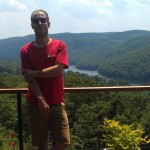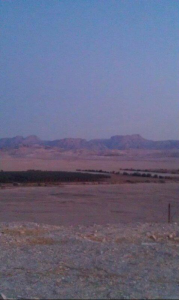Musings from Students of the Pardes Institute of Jewish Studies in Jerusalem
Posted on May 17, 2013 by Tani Cohen-Fraade
 In Rabbi Meir Schewiger’s Parashat ha-Shavuah (weekly Torah Portion) class, while learning Sefer Shemot (Book of Exodus), we spoke about the desert as a place where one goes to prepare for Torah study. When B’nei Yisrael (Children of Israel) leave Egypt, they flee through the desert and are on the run until they get to Yam Suf (Red Sea) and cross to safety. Even after getting to Har Sinai (Mt. Sinai) and receiving the Torah, they still spend another 40 years in the desert wandering and preparing to enter into the Land. On the festival of Shavuot, we celebrate Zman Matan Torateinu (our receiving of the Torah at Sinai). We have just finished counting the Omer, the period of time from Pesach up to Shavuot and while we have now received the Torah and have celebrated this by a long night of learning and Torah study, B’nei Yisrael is still in the desert. For the rest of this year, leading up to the Yamim Noraim (Days of Awe) and Simchat Torah, we will continue to follow them as they travel through the wilderness in preparation for their entry into Eretz Yisrael (Land of Israel). I liked the idea of the desert as a place for preparation and when I thought back over the last few years of my life I began to like it even more.
In Rabbi Meir Schewiger’s Parashat ha-Shavuah (weekly Torah Portion) class, while learning Sefer Shemot (Book of Exodus), we spoke about the desert as a place where one goes to prepare for Torah study. When B’nei Yisrael (Children of Israel) leave Egypt, they flee through the desert and are on the run until they get to Yam Suf (Red Sea) and cross to safety. Even after getting to Har Sinai (Mt. Sinai) and receiving the Torah, they still spend another 40 years in the desert wandering and preparing to enter into the Land. On the festival of Shavuot, we celebrate Zman Matan Torateinu (our receiving of the Torah at Sinai). We have just finished counting the Omer, the period of time from Pesach up to Shavuot and while we have now received the Torah and have celebrated this by a long night of learning and Torah study, B’nei Yisrael is still in the desert. For the rest of this year, leading up to the Yamim Noraim (Days of Awe) and Simchat Torah, we will continue to follow them as they travel through the wilderness in preparation for their entry into Eretz Yisrael (Land of Israel). I liked the idea of the desert as a place for preparation and when I thought back over the last few years of my life I began to like it even more.
In the fall of 2010, I had been living and working at home in Connecticut, teaching in the Jewish community for a year after graduating college and I was ready for a change. I volunteered with the Kibbutz Program Center and after consulting with friends of friends, was placed on Kibbutz Yahel in the very south of Israel, about a 40 minutes north of Eilat in a region called the Arrava. Arrava means wilderness and this was exactly what I found when I got there. This was the absolute middle of nowhere. All in all, I spent two seasons on Kibbutz Yahel, almost two years living and working in the desert. The time that I spent in the Arrava was life changing. To wake up at the crack of dawn, work all day doing physical labor and not return home until it was getting dark was a breath of fresh air. During this time I learned how to operate heavy machinery, work in a kibbutz kitchen and more about packaging fruits and vegetables than I had ever hoped to know previously.  Living at Yahel also meant finding solace in the desert and every day off or day that I got out of work early, I spent taking in these new sights and getting to know my ever expanding backyard. As someone who had always been used to city life, it was freeing to live in a place where I could walk out my door and be staring at the reddish Jordanian mountains. At the end of my second season working in warehouses packaging peppers, melons, dates, garlic and onions I was again ready for a change. My search to get back into Jewish Education and become a better teacher led me to Pardes and the Pardes Educators Program where I am now about to finish my first year of a two year program in intensive Jewish Learning and a masters degree in Jewish education. I like to think of my time at Yahel and in the desert as my preparation before entering back into the world of education and serious Torah study. While I toiled and even did some wandering in the desert, I am now living in Jerusalem where I am lucky enough to learn daily from my incredible teachers at Pardes. I’m not sure what my transition to Pardes would have been like if I had come directly from home but something about my time on kibbutz had prepared me to start something completely different. Now, even though I have left the physical desert, I am in another stage of preparation. In a little more than a year, I will leave Jerusalem and Pardes to work in a Jewish Day school in the United States where I will teach Torah and become part of a new community. Just as my two years of working and living in the desert prepared me to come to Jerusalem, I am confident that my time here will prepare me for what is to come next.
Living at Yahel also meant finding solace in the desert and every day off or day that I got out of work early, I spent taking in these new sights and getting to know my ever expanding backyard. As someone who had always been used to city life, it was freeing to live in a place where I could walk out my door and be staring at the reddish Jordanian mountains. At the end of my second season working in warehouses packaging peppers, melons, dates, garlic and onions I was again ready for a change. My search to get back into Jewish Education and become a better teacher led me to Pardes and the Pardes Educators Program where I am now about to finish my first year of a two year program in intensive Jewish Learning and a masters degree in Jewish education. I like to think of my time at Yahel and in the desert as my preparation before entering back into the world of education and serious Torah study. While I toiled and even did some wandering in the desert, I am now living in Jerusalem where I am lucky enough to learn daily from my incredible teachers at Pardes. I’m not sure what my transition to Pardes would have been like if I had come directly from home but something about my time on kibbutz had prepared me to start something completely different. Now, even though I have left the physical desert, I am in another stage of preparation. In a little more than a year, I will leave Jerusalem and Pardes to work in a Jewish Day school in the United States where I will teach Torah and become part of a new community. Just as my two years of working and living in the desert prepared me to come to Jerusalem, I am confident that my time here will prepare me for what is to come next.
As I sat at Pardes a during the Tikkun Leil Shavuot, after a wonderful potluck meal with friends (which of course ended with cheesecake), I thought about all of this and I thought about what exactly it is that we celebrate on this holiday. Shavuot is by no means a celebration of completion. In fact, even when we do celebrate completing the cycle of Torah reading on Simchat Torah, the first thing we do is start it again. If anything, Shavuot is a celebration of a new beginning. We commemorate B’nei Yisrael receiving the Torah at Sinai, we engage in a night of intensive learning, and then we continue our annual cycle of Torah reading. The learning that we do on Shavuot celebrates not just the gift of Torah, but how we can apply it to our lives. Even though B’nei Yisrael would continue to wander in the desert for another 40 years, they now had the beginning of a system of law as well as expectations for how to live when they would reach the land.
When I sat reflecting on this year, on my leaving kibbutz and coming to Jerusalem, a thought struck me. Maybe I haven’t completely left the desert. In fact, maybe we never leave the desert at all. We spend our lives working towards various goals, milestones and events, and maybe that is what the desert is. B’nei Yisrael traveled through the desert, received the Torah and then traveled some more, to live in a region of the world which is mostly a desert. whether it is through living in Israel, engaging in Torah study, or whether it is by recounting the story year by year of our ancestors’ travels to get to Eretz Yisrael, it is my hope for us all that we find what we are looking for, but that we also all continue to find deserts of our own, places to challenge us and to prepare us for wherever we go next.